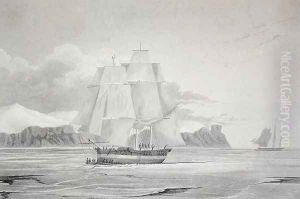Hoppner, Captain Paintings
John Hoppner was an English portrait painter, often associated with the style of Romanticism, who came to prominence towards the end of the 18th century. Born on April 4, 1758, in London, his early life is shrouded in mystery with some sources suggesting he may have been a son of the German Prince Frederick of Prussia, who was placed in the care of a nurse named Hoppner. Despite the intrigue of his lineage, Hoppner's artistic talent is well-documented and was his own. He attended the Royal Academy schools in London, where he developed his skills and was influenced by the works of Sir Joshua Reynolds, the leading English portraitist of the era.
Hoppner first exhibited at the Royal Academy in 1780, quickly establishing himself as a portraitist of note. He became a favorite among the members of the royal court and the British aristocracy, capturing the likenesses of some of the most prominent figures of his time. His rivalry with Thomas Lawrence, another leading portraitist, was well-known, as they both vied for the patronage of the elite. Despite this competition, Hoppner's work was celebrated for its sensitivity, particularly in the depiction of women and children, and he was praised for the naturalistic portrayal of his subjects.
In 1793, Hoppner was appointed Portrait Painter to the Prince of Wales, the future King George IV, which secured his status as one of the most sought-after portraitists in Britain. His works from this period are characterized by a rich, vibrant palette and a masterful use of light and shadow, features that have led some to compare his work favorably with that of Reynolds. Hoppner's portraits are noted for their psychological depth and the subtle capturing of his sitters' personalities.
John Hoppner's health began to decline in the early 19th century, and he passed away on January 23, 1810, in London. His legacy is preserved in the collections of major museums around the world, including the National Portrait Gallery in London and the Metropolitan Museum of Art in New York. Hoppner's contribution to British portraiture and the Romantic movement remains significant, and his works continue to be studied and admired for their beauty and depth.
